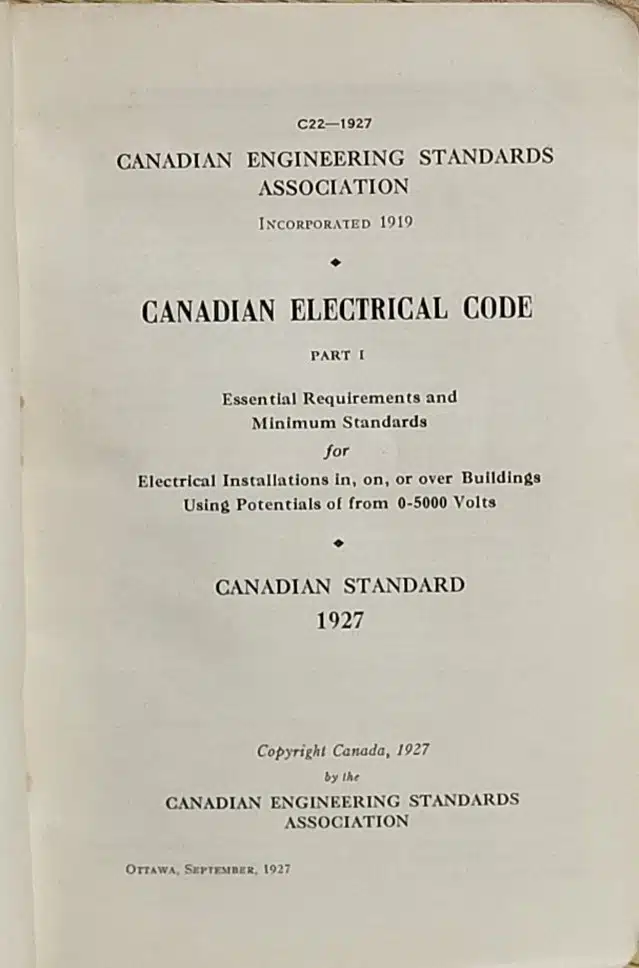Last edit: 19/03/2024

The CE Code, or Canadian Electrical Code or CSA C22.1 is the reference standard for Electrical Safety in Canada. It is the equivalent of the NFPA 70 (or NEC) in USA. The equivalent standard in our IEC field is the IEC 60364 series. The main difference between the IEC series of standards and the CE Code is that the latter is writter for the Electrical Contractor or Installer who builds the Electrical Installation, while the former is addressed to the Electrical Engineer who designs it. That is one of the reasons why both the CE Code and the NEC are prescriptive.
On the 4th March 2024 a new edition of the CE Code was published! The CE Code requires warning labels to be displayed on the Machine Control Panel. The languase should be the official one in the province and in general, all safety signs sould be in both English and French. Examples of warning labels are the one for the Arc Flash, required in Rule 2-306 and the one for dangerous voltages (Rule 36-006).
General arrangement
The Code is divided into numbered Sections, each covering some main division of the work. Sections 0 to 16 and 26 are considered general Sections, and the other Sections supplement or amend the general Sections.
Among the most important Sections:
- Section 4 — Conductors. It contains for example the Rule 4-004 on the corrective factors for the different types of installation. The idea of correcting the “reference Ampacity” based upon the installation method is present in all International Standards (IEC 60364 and NFPA 70 for example)
- Section 8 — Circuit loading and demand factors. It contains the Rule 8-104 on Continuous load. Very specific to the Canadian Market
- Section 12 — Wiring methods. It contains the wiring rules; for example Rule 12-2200 for Cable Trays and allowed Cables in Cables Trays.
The Sections are divided into numbered Rules, with captions for easy reference, as follows:
- Numbering system — With the exception of Section 38, even numbers have been used throughout to identify Sections and Rules. Rule numbers consist of the Section number separated by a hyphen from the 3- or 4-digit figure. The intention in general is that odd numbers may be used for new Rules required by interim revisions. Due to the introduction of some new Rules and the deletion of some existing Rules during the revision of each edition, the Rule numbers for any particular requirement are not always the same in successive editions.
- Subdivision of Rules — Rules are subdivided in the manner illustrated by Rules 8-204 and 8-206, and the subdivisions are identified as follows:
- Rule
- 1) Subrule
- 1) a) item
Please notice how the CE Code has “Rules” while the NFPA standards have “articles” and the UL Standards have “sections”!
Main Changes in the 2024 Edition
Section 64 contains major revisions for energy storage and renewable energy systems, including a new Subsection for residential occupancies and updates to photovoltaic system requirements. Several important changes appear in Section 68, including new requirements for disconnecting means and bonding conductive pool infrastructure.
Section 66 now requires ground fault circuit interrupter protection for cords connected to receptacles placed in temporary installations such as tents for outdoor functions.
Other significant revisions in this edition include the following:
- voltage definitions for dc circuit voltages have been revised in Section 0; Finally USA and Canada are aligned for Extra Low Voltage Values: 30 Vac and 60 Vdc
- Section 2 sees the addition of new requirements for reduction of arcing fault clearing times and clarification on use of ingress protection designations; be aware if you are designing an Industrial Control Panel with a Nominal current of 1200 A or higher!
- In addition to traditional AWG and kcmil sizes, use of conductors sized in mm2 is now recognized through revisions to Section 4 and a new table. A sign that the Canadian Electrical Code, despite being written in a prescrictive language like the NEC is open to the IEC standards!
- Load calculations for installations with electric vehicle supply equipment have been revised in Section 8 and simplified through the deletion of Table 38;
- Many new products and updates to wiring methods are recognized in Section 12, including sag and span requirements for overhead installations and new Rules for non-metallic jacketed cable;
- Sealing requirements have been substantially revised in Section 18 and Annex J18;
- Section 36 now features Rules for installation of high-voltage couplers (i.e., devices that provide a means to repeatedly join and separate portable power cables);
- Table 11 has been reformatted into two new tables (11A and 11B) and made easier to use through a layout similar to Table 19;
- Annexes A.1 and A.2 of Appendix A and the Index have been reinstated;
- Appendix K has been deleted; and
- The word “allowable” has been removed from “allowable ampacities” throughout most of the Code. That way the normative language becomes “lighter”.
The First Edition of the CE Code

The preliminary work in preparing the Canadian Electrical Code began in 1920 when a special committee, appointed by the main Committee of the Canadian Engineering Standards Association, recommended its development. A third meeting of this Committee was held in June 1927 with representatives from Nova Scotia, Québec, Ontario, Manitoba, Saskatchewan, and British Columbia in attendance. At this meeting, the revised draft, which had been discussed at the previous two meetings, was formally approved and it was resolved that it be printed as Part I of the Canadian Electrical Code.